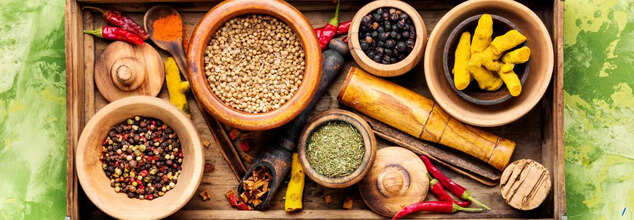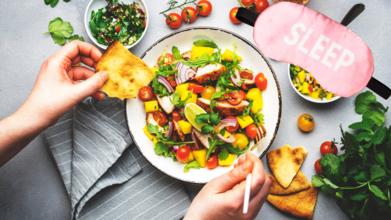- Health Conditions A-Z
- Health & Wellness
- Nutrition
- Fitness
- Health News
- Ayurveda
- Videos
- Medicine A-Z
- Parenting
- Web Stories
Spices Can Lower Your Blood Pressure—But Is There Empirical Evidence?

Credit: Canva
A few days earlier, I had felt a strange sensation in my chest. I could feel my heart struggling to pump blood. Upon getting several blood tests done, I discovered that my blood pressure (BP) was above the normal. It was then that I started reading about how to lower it, and to my surprise, I discovered that the key lies in basic ingredients—spices.
Here's What Science Says
There is enough evidence that shows spices actually reduce blood pressure. Here are studies that support it:1. Cinnamon
A recent study published in Clinical Nutrition Open Science showed that cinnamon can considerably reduce fasting blood sugar and insulinemia (how the body responds to blood sugar). The results showed that cinnamon, turmeric, ginger, black cumin, and saffron significantly decreased fasting glucose in T2DM subjects.
2. Cardamom
It has been suggested that the antioxidant, anti-inflammatory, and hypolipidemic activities of cardamom may improve diabetes. A study published in the National Library of Medicine in January 2018 supported this claim.
3. Turmeric – A meta-analysis published in Pharmacol Resolution in 2019 suggests that consuming curcumin or turmeric may improve systolic blood pressure (SBP), particularly when administered over longer durations. Since SBP represents the pressure in the arteries when the heart beats, its reduction plays a key role in lowering overall blood pressure. Even modest improvements in SBP can significantly decrease the risk of cardiovascular events such as heart disease and stroke.
4. Ginger
Ginger has long been a favourite in Indian kitchens—not just for its bold flavour, but also for its healing touch. Beyond easing colds and nausea, science now shows it may support heart health too. A 2019 study published in Phytotherapy Research analysed six clinical trials and found that ginger significantly lowered both systolic and diastolic blood pressure. The effect was more noticeable in younger individuals and when taken in higher doses (around 3 grams per day) over shorter durations (up to 8 weeks).
5. Coriander
A 2008 study on coriander extract (Cs.Cr) revealed that it interacts with the body in interesting ways—initially stimulating intestinal muscles but later relaxing them, especially in the presence of certain compounds. In animal studies, it helped lower blood pressure, relax blood vessels, slow the heart rate, and even increase urine output. Researchers believe this is due to its calcium channel-blocking effects, similar to some prescription heart medications.
6. Black Pepper
A study published in the Bratislava Medical Journal showed that oral administration of piperine, an alkaloid in black pepper, is able to partially prevent the increase of blood pressure caused by chronic L-NAME administration. This effect is probably caused by the blockage of voltage-dependent calcium channels and supported by filamentous actin disassembly.
7. Cumin
Several studies have shown that cumin may help people control their cholesterol levels. In one study, cumin powder dissolved in yogurt helped reduce "bad" (LDL) cholesterol and triglycerides while increasing "good" (HDL) cholesterol. Good cholesterol (HDL) helps remove excess bad cholesterol from the bloodstream, reducing plaque buildup in arteries. This lowers the risk of heart disease, stroke, and supports overall cardiovascular health.
Can Food Really Boost Fertility? Nutritionist Shares What To Eat When You Are Trying To Conceive

Credits: Canva
When couples decide they’re ready to start a family, the focus often shifts to medical tests, ovulation tracking, and lifestyle changes but what if the way to parenthood began not in a clinic but in your kitchen? Something many overlook, what’s on your plate might be just as important as what’s your schedule. Fertility isn’t only about biology; it’s also about nourishment. The right foods can influence hormone balance, improve egg and sperm quality, and create a healthier environment for conception. So before you rush into supplements or stressful routines, it’s worth asking: could your daily meals be quietly shaping your chances of conceiving?
For many couples who are struggling to conceive, this quest feels both hopeful and overwhelming. While modern medicine acknowledges fertility treatments like IVF and IUI, it often falls short of offering solutions for couples trying naturally. That gap is where your diet and traditional approaches like Ayurveda can possibly step in. From Harvard’s recent review on fertility nutrition to ancient Ayurvedic practices, food is increasingly being recognized as a powerful ally in conception.
How Is Diet And Fertility Connected?
A sweeping review from the Harvard T.H. Chan School of Public Health and Harvard Medical School examined dozens of studies exploring diet and fertility. Their findings underline what many nutritionists have long suggested: what you eat can influence how quickly—or whether—you conceive.
For women, diets rich in folic acid, vitamin B12, and omega-3 fatty acids were linked to improved fertility outcomes. The Mediterranean diet, known for its vegetables, legumes, lean proteins, and olive oil, also appeared beneficial. In contrast, diets heavy in trans fats, red and processed meats, sugary drinks, and fast foods correlated with longer times to pregnancy and reduced fertility.
For men, the story was similar. Healthy diets improved semen quality, while high intake of saturated and trans fats had the opposite effect. While semen quality isn’t the perfect marker for male fertility, the evidence points toward lifestyle choices influencing reproductive health.
Interestingly, the study found little effect—positive or negative—from antioxidants, vitamin D, dairy, soy, caffeine, or alcohol when it came to fertility outcomes. That doesn’t mean these foods are irrelevant, but the strongest signals came from folate, B12, omega-3s, and an overall nutrient-dense dietary pattern.
How Can An Ayurvedic Diet Boost Fertility?
Celebrity Ayurvedic Nutritionist Shweta Shah explains that Ayurveda views fertility not just as a physical process but as an indicator of overall vitality. At its core lies ojas, described as the essence of health and immunity. “For conception to occur, ojas must be strong, digestion (agni) steady, and the doshas balanced,” she says.
One traditional ritual Shah recommends is a warm saffron-cardamom milk tonic, ideally consumed in the evening. The tonic combines saffron’s hormone-balancing and mood-stabilizing properties with cardamom’s ability to enhance circulation and nutrient delivery to reproductive tissues. “Warm milk nourishes shukra dhatu, the reproductive tissue supporting egg health and vitality,” Shah adds. Taken regularly, the tonic is said to build ojas, improve sleep, and even enhance desire, creating harmony in the reproductive system.
What to Add To Your Fertility Plate: What to Eat, What to Limit
Both modern nutrition and Ayurveda agree on one key point: fertility thrives on balance.
Foods to embrace include cooked whole grains, legumes, leafy vegetables, healthy fats like ghee, sesame oil, soaked nuts, and omega-rich seeds such as flax and chia. In Ayurveda, warm, cooked meals are emphasized to support digestion and nutrient absorption.
Spices like cumin, fennel, turmeric, and cinnamon are not just flavor enhancers; they improve circulation and balance hormones. Herbs such as ashwagandha and shatavari are often recommended for reproductive support.
What to avoid: Refined sugar, excess caffeine, alcohol, irregular eating patterns, and overexertion. Shah explains, “These deplete ojas, disturb digestion, and create imbalance in the body.”
Why Lifestyle Is The Missing Piece in Fertility Conversations?
Diet alone cannot guarantee conception. Both research and Ayurveda highlight lifestyle factors—sleep, stress, and physical activity—as critical players in fertility. The Harvard review pointed out that women who consumed more fast food and fewer fruits took longer to conceive, while those who included more seafood in their diet got pregnant faster. Similarly, Ayurveda stresses mindful living, gentle movement, self-care rituals like abhyanga (warm oil massage), and emotional connection.
Shah puts it simply, “Conception is not just reproduction—it’s a sacred invitation. It requires nourishment, balance, and an environment of emotional safety.”
So, can food really boost your chances of pregnancy? The evidence suggests it can certainly help—but it’s not a magic bullet. Fertility is influenced by a tapestry of factors, from age and genetics to environmental exposures. What diet can do is optimize the conditions for conception, supporting both egg and sperm health, and preparing the body for a healthy pregnancy.
As Shah reminds us, “When we align with nature—through what we eat, how we live, and how we connect emotionally—we create the most fertile ground for life to flourish.”
Nutritionist Explains The 5 Evening Habits That Help You Wake Up Energized

Credits: Health and me
What’s the first thing you feel when you wake up in the morning light and energized, or heavy and sluggish? For many people, the answer has less to do with how many hours they slept and more with what they ate the night before. Nutritionists say your dinner choices can set the tone for your digestion, sleep quality, and even your morning energy levels. The question you should ask yourself is, are your nighttime eating schedule working for you or against you?
The answer may not lie in a new mattress, a sleep app, or even a strict bedtime routine—it could be sitting right on the dinner table. Sleep specialists and nutritionists agree that the way we eat in the evening plays a powerful role in how well we rest and how efficiently our bodies recover overnight.
With nearly one-third of US adults routinely falling short on sleep, according to the Centers for Disease Control and Prevention (CDC), understanding the connection between food and sleep quality has become more than a lifestyle trend, it’s a public health concern. From nutrient timing to mindful eating, science increasingly points to a two-way relationship: just as sleep influences hunger and metabolism, nutrition can either sabotage or support deep, restorative rest.
Overlooked Link Between Nutrition and Sleep
Research shows that diets high in sugar, saturated fat, and processed foods are consistently linked to restless or fragmented sleep. Meanwhile, balanced diets rich in fiber, lean protein, and complex carbohydrates appear to promote more consistent and restorative sleep cycles. Even the timing of dinner matters. Late-night eating, particularly heavy meals, forces the digestive system to stay active at a time when it should be winding down, often leading to indigestion, reflux, or interrupted sleep.
“Your last meal of the day can play a powerful role in how well your body digests food and how deeply you sleep,” says clinical nutritionist Prachi Mandholia. “When dinner is timed and balanced correctly, it allows the body to rest and repair overnight instead of being overworked.”
Can Eating Dinner Early Helps the Body Reset?
One of the simplest yet most effective changes is to finish dinner two to three hours before bedtime. Research has long suggested that late-night eating is associated with a higher risk of gastroesophageal reflux disease (GERD) and disrupted sleep cycles.
“An early, lighter meal gives your body time to process food calmly,” explains Mandholia. “This reduces the likelihood of acidity, bloating, or heaviness, all of which can make falling asleep and staying asleep more difficult.”
For those accustomed to late dinners due to work or social commitments, shifting mealtimes even slightly earlier can help. Experts recommend pairing this with smaller, nutrient-dense evening meals rather than heavy, multi-course spreads.
Why It Is Important to Build a Balanced Dinner Plate?
Nutritionists emphasize that not just timing, but composition matters. Heavy, greasy, or overly spicy foods tend to delay digestion and disturb sleep. Instead, a dinner plate that includes seasonal vegetables, lean proteins such as fish or legumes, and complex carbohydrates like quinoa, brown rice, or millets provides both satiety and stability.
This combination ensures a steady release of energy overnight, which prevents sudden spikes or drops in blood sugar—a common cause of nighttime wakefulness. A balanced meal also keeps the digestive system from becoming overloaded, allowing the body to direct more energy toward repair and recovery during sleep.
What Role Do Sleep-Friendly Foods Play?
Certain foods contain nutrients that can directly influence the body’s ability to relax. Tryptophan, an amino acid found in foods like turkey, nuts, and seeds, helps boost serotonin and melatonin levels—two hormones critical for sleep regulation. Magnesium, present in almonds and pumpkin seeds, relaxes the nervous system, while melatonin-rich foods like cherries may naturally encourage drowsiness.
“Adding a small handful of almonds, walnuts, or pumpkin seeds to your evening routine can prepare your body for rest,” notes Mandholia. Importantly, these are not meant as large bedtime snacks but as thoughtful additions to an early evening meal.
Mindful Eating Over Mindless Habits
What we eat is only half of the equation—how we eat matters too. Eating in front of the television, scrolling through social media, or rushing through a meal often leads to overeating and indigestion. Studies on mindful eating show that slowing down, chewing thoroughly, and paying attention to flavors improves digestion and helps the body recognize satiety cues.
“Mindful eating improves digestion, prevents overeating, and allows you to feel satisfied at the right time,” says Mandholia. The practice also creates a calming pre-sleep ritual, lowering stress and signaling to the body that it’s time to wind down.
Hydration is Important But at the Right Time
Hydration is essential for overall health, but drinking large amounts of fluids too close to bedtime can disrupt sleep by causing frequent nighttime bathroom trips. Instead, experts recommend prioritizing water intake earlier in the day and tapering off by evening. If you’re prone to dry mouth or dehydration at night, a small sip of water before bed is usually sufficient without interrupting rest.
The effects of nighttime eating habits extend beyond one night of rest. Poor sleep, fueled by heavy or late dinners, can increase cravings for sugary and fatty foods the next day, perpetuating a cycle of poor nutrition and sleep deprivation. Over time, this cycle may raise the risk of obesity, type 2 diabetes, and cardiovascular disease.
On the other hand, cultivating evening habits that support digestion and sleep creates a positive feedback loop. A well-rested body regulates appetite better, digests food more efficiently, and is less likely to store excess energy as fat.
As Mandholia puts it, “A restful night truly begins on your dinner plate.” Simple shifts like eating earlier, choosing balanced meals, including sleep-friendly foods, practicing mindful eating, and hydrating smartly, can transform not just how we sleep, but how we feel when we wake.
Why Americans Consume Too Much Sugar? Study Says The Answer Lies In Hot Climate

Credits: Canva
It’s no secret that Americans consume too much sugar, a fact public health guidelines have long warned about. Now, a new study suggests that the sweltering summer months may be driving sugar consumption even higher. Researchers have found that rising temperatures are linked to increased intake of sugary foods and beverages, pointing to heat as a subtle yet significant factor in Americans’ sweet tooth.
The study, published this week in Nature Climate Change, tracked grocery purchases from American households over several years. By comparing these purchases to local weather records, researchers were able to identify a clear pattern: as temperatures climb, so does sugar consumption.
Sugar Spikes in the Summer
Pan He, an environmental scientist at Cardiff University and a co-author of the study, explains, “As temperatures get higher, people tend to increase their added sugar consumption.” The research showed that for every degree Celsius rise in temperature, Americans added about 0.7 grams of sugar per day, roughly an eighth of a teaspoon.
Most of this increase came from sugary beverages like sodas, energy drinks, and sweetened juices. Duo Chan, a climate scientist at the University of Southampton and another study author, notes that those who regularly consume sugar-laden drinks were more than five times more likely to drink more during hot weather. “It’s intuitive,” he says. “People need more liquid when it’s hot. If sugary drinks are already a habit, they naturally increase their intake.”
Health Risks of Sweet Choices
Public health experts have long cautioned against excessive sugar intake, especially from beverages. Lindsey Smith Taillie, a nutrition scientist at the University of North Carolina, explains that sugary drinks are particularly concerning because they don’t trigger fullness. “Drinking sugar is a really fast and easy way to overconsume sugar, specifically, and just consume too much in general,” she says.
Consuming too much sugar is linked not only to dental cavities but also to chronic health conditions such as diabetes, heart disease, high blood pressure, and even changes in the gut microbiome. Laura Lara-Castor, an epidemiologist at the Institute for Health Metrics and Evaluation, emphasizes that sugar-sweetened beverages remain the single largest contributor to sugar overconsumption in the U.S.
During hot weather, Lara-Castor adds, hydration needs increase. “The type of liquids people choose can have long-term health impacts,” she says. “Whether people have access to safe drinking water, or turn to sugary beverages instead—can shape overall health outcomes.” Public policy, she notes, plays a role too: soda taxes, clean water accessibility, and social norms all influence sugar intake.
A Sweeter Future?
The study also raises concerns about the long-term impact of climate change on sugar consumption. With global temperatures projected to rise by 2.7 degrees Celsius by 2100, the researchers estimate that the average American could consume over a pound of extra sugar annually. Multiplied across the U.S. population, that equates to more than 4 billion cans of soda each year.
“This is quite an astonishing number,” Chan says. The findings underscore a subtle but important consequence of a warming world: hotter summers could inadvertently encourage Americans to reach for more sugar, amplifying existing health challenges.
Public health strategies, experts say, must focus on making healthier choices—like water—more accessible and appealing. In a hotter world, quenching thirst without fueling sugar overload may be a key challenge for the nation’s health.
© 2024 Bennett, Coleman & Company Limited

